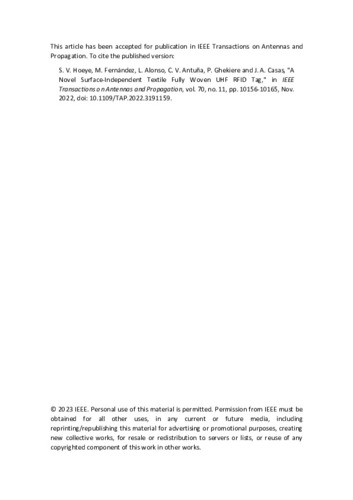A novel surface-independent textile fully woven UHF RFID tag
Palabra(s) clave:
Antennas
RFID tag
Textile technology
Fecha de publicación:
Editorial:
IEEE
Versión del editor:
Citación:
Descripción física:
Resumen:
In this work, a UHF broadband surfaceindependent textile fully woven radio frequency identification (RFID) tag is presented. The antenna is composed of two stacked multilayer fabric pieces in which the shaped conductive and dielectric surfaces are part of the woven structure. In addition, a novel technique for the integration of the RFID chip in the woven structure was developed, providing a maximum integration level and making possible the manufacturing of the tag in a single step using conventional machinery from the textile industry. A tag prototype was experimentally characterized, showing a 12.5 m read range under a ±60 × ±60º angular range, when using a circularly polarized interrogator device with 35.2 dBm effective isotropic radiated power (EIRP).
In this work, a UHF broadband surfaceindependent textile fully woven radio frequency identification (RFID) tag is presented. The antenna is composed of two stacked multilayer fabric pieces in which the shaped conductive and dielectric surfaces are part of the woven structure. In addition, a novel technique for the integration of the RFID chip in the woven structure was developed, providing a maximum integration level and making possible the manufacturing of the tag in a single step using conventional machinery from the textile industry. A tag prototype was experimentally characterized, showing a 12.5 m read range under a ±60 × ±60º angular range, when using a circularly polarized interrogator device with 35.2 dBm effective isotropic radiated power (EIRP).
ISSN:
Patrocinado por:
European Commission EUROSTARS Program, con contrato E!11802 Ministerio de Ciencia e Innovación (MCIN)/Agencia Estatal de Investigación (AEI), con proyectos PID2021-126301NA-I00 y EQC2019-005768-P; Gobierno del Principado de Asturias (PCTI), FEDER con proyectos AYUD/2021/51706, IDI/2016/000372, IDI/2017/000083, IDI/2018/000191, y IDI/2021/000207; Universidad de Oviedo, con proyecto GR-2010-0015.
Colecciones
Ficheros en el ítem




